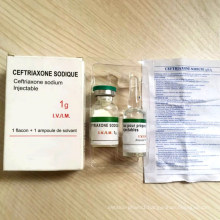Antibiotic Cipro Capsule for Infections
Basic Info
Model No.: DAWACC00001
Product Description
Model NO.: DAWACC00001 Usage Mode: For oral administration State: Solid Type: Biological Products Name: Ciprofloxaci Capsule OEM: Acceptable Storage: Place and Shade Transport Package: 10caps/Blister/Box Origin: France Application: Internal Medicine Suitable for: Elderly, Children, Adult Shape: Capsules Pharmaceutical Technology: Chemical Synthesis Administration Route: Oral MOQ: 1 Box Trademark: GUYENNE Specification: 250mg, 500mg Antibiotic Ciprofloxaci Capsule For Infections
Ciprofloxaci is an antibiotic used to treat a number of bacterial infections. This includes bone and joint infections, intra abdominal infections, certain type of infectious diarrhea, respiratory tract infections, skin infections, typhoid fever, and urinary tract infections, among others.For some infections it is used in addition to other antibiotics. It can be taken by mouth or used intravenously.
Common side effects include nausea, vomiting, diarrhea, and rash. Ciprofloxaci increases the risk of tendon rupture and worsening muscle weakness in people with the neurological disorder myasthenia gravis. Rates of side effects appear to be higher than some groups of antibiotics such as cephalosporins but lower than others such as clindamycin. Studies in other animals raise concerns regarding use in pregnancy.No problems were identified; however, in the children of a small number of women who took the medication.It appears to be safe during breastfeeding. It is a second-generation fluoroquinolone with a broad spectrum of activity that usually results in the death of the bacteria.
Medical uses
Ciprofloxaci is used to treat a wide variety of infections, including infections of bones and joints, endocarditis, gastroenteritis, malignant otitis externa, respiratory tract infections, cellulitis, urinary tract infections, prostatitis, anthrax, and chancroid.
Ciprofloxaci only treats bacterial infections; it does not treat viral infections such as the common cold. For certain uses including acute sinusitis, lower respiratory tract infections and uncomplicated gonorrhea, ciprofloxaci is not considered a first-line agent.
Ciprofloxaci occupies an important role in treatment guidelines issued by major medical societies for the treatment of serious infections, especially those likely to be caused by Gram-negative bacteria, including Pseudomonas aeruginosa. For example, ciprofloxaci in combination with metronidazole is one of several first-line antibiotic regimens recommended by the Infectious Diseases Society of America for the treatment of community-acquired abdominal infections in adults. It also features prominently in treatment guidelines for acute pyelonephritis, complicated or hospital-acquired urinary tract infection, acute or chronic prostatitis, certain types of endocarditis,certain skin infections,and prosthetic joint infections.
In other cases, treatment guidelines are more restrictive, recommending in most cases that older, narrower-spectrum drugs be used as first-line therapy for less severe infections to minimize fluoroquinolone-resistance development. For example, the Infectious Diseases Society of America recommends the use of ciprofloxaci and other fluoroquinolones in urinary tract infections be reserved to cases of proven or expected resistance to narrower-spectrum drugs such as nitrofurantoin or trimethoprim/sulfamethoxazole.The European Association of Urology recommends ciprofloxacin as an alternative regimen for the treatment of uncomplicated urinary tract infections, but cautions that the potential for "adverse events have to be considered".
Although approved by regulatory authorities for the treatment of respiratory infections, ciprofloxaci is not recommended for respiratory infections by most treatment guidelines due in part to its modest activity against the common respiratory pathogen Streptococcus pneumoniae."Respiratory quinolones" such as levofloxacin, having greater activity against this pathogen, are recommended as first line agents for the treatment of community-acquired pneumonia in patients with important co-morbidities and in patients requiring hospitalization (Infectious Diseases Society of America 2007). Similarly, ciprofloxaci is not recommended as a first-line treatment for acute sinusitis.
Ciprofloxaci is approved for the treatment of gonorrhea in many countries, but this recommendation is widely regarded as obsolete due to resistance development.
Pregnancy
In the United States ciprofloxaci is pregnancy category C.This category includes drugs for which no adequate and well-controlled studies in human pregnancy exist, and for which animal studies have suggested the potential for harm to the fetus, but potential benefits may warrant use of the drug in pregnant women despite potential risks. An expert review of published data on experiences with ciprofloxaci use during pregnancy by the Teratogen Information System concluded therapeutic doses during pregnancy are unlikely to pose a substantial teratogenic risk (quantity and quality of data=fair), but the data are insufficient to state no risk exists.
Two small post-marketing epidemiology studies of mostly short-term, first-trimester exposure found that fluoroquinolones did not increase risk of major malformations, spontaneous abortions, premature birth, or low birth weight.The label notes, however, that these studies are insufficient to reliably evaluate the definitive safety or risk of less common defects by ciprofloxaci in pregnant women and their developing fetuses.
Breastfeeding
Fluoroquinolones have been reported as present in a mother's milk and thus passed on to the nursing child. The U.S. FDA recommends that because of the risk of serious adverse reactions (including articular damage) in infants nursing from mothers taking ciprofloxaci, a decision should be made whether to discontinue nursing or discontinue the drug, taking into account the importance of the drug to the mother.
Children
Oral and intravenous ciprofloxaci are approved by the FDA for use in children for only two indications due to the risk of permanent injury to the musculoskeletal system:
1) Inhalational anthrax (postexposure)
2) Complicated urinary tract infections and pyelonephritis due to Escherichia coli, but never as first-line agents. Current recommendations by the American Academy of Pediatrics note the systemic use of ciprofloxaci in children should be restricted to infections caused by multidrug-resistant pathogens or when no safe or effective alternatives are available.
Spectrum of activity
Its spectrum of activity includes most strains of bacterial pathogens responsible for respiratory, urinary tract, gastrointestinal, and abdominal infections, including Gram-negative (Escherichia coli, Haemophilus influenzae, Klebsiella pneumoniae, Legionella pneumophila, Moraxella catarrhalis, Proteus mirabilis, and Pseudomonas aeruginosa), and Gram-positive (methicillin-sensitive, but not methicillin-resistant Staphylococcus aureus, Streptococcus pneumoniae, Staphylococcus epidermidis, Enterococcus faecalis, and Streptococcus pyogenes) bacterial pathogens.
Bacterial resistance
As a result of its widespread use to treat minor infections readily treatable with older, narrower spectrum antibiotics, many bacteria have developed resistance to this drug in recent years, leaving it significantly less effective than it would have been otherwise.
Resistance to ciprofloxaci and other fluoroquinolones may evolve rapidly, even during a course of treatment. Numerous pathogens, including enterococci, Streptococcus pyogenes and Klebsiella pneumoniae (quinolone-resistant) now exhibit resistance.Widespread veterinary usage of the fluoroquinolones, particularly in Europe, has been implicated. Meanwhile, some Burkholderia cepacia, Clostridium innocuum and Enterococcus faecium strains have developed resistance to ciprofloxaci to varying degrees.
Fluoroquinolones had become the class of antibiotics most commonly prescribed to adults in 2002. Nearly half (42%) of those prescriptions in the U.S. were for conditions not approved by the FDA, such as acute bronchitis, otitis media, and acute upper respiratory tract infection, according to a study supported in part by the Agency for Healthcare Research and Quality. Additionally, they were commonly prescribed for medical conditions that were not even bacterial to begin with, such as viral infections, or those to which no proven benefit existed.
Contact us if you need more details on Ciloxan. We are ready to answer your questions on packaging, logistics, certification or any other aspects about Ciprofloxaci、Cipro. If these products fail to match your need, please contact us and we would like to provide relevant information.
| Specification | 250mg, 500mg |
| Package | 10caps/blister/box |
Ciprofloxaci is an antibiotic used to treat a number of bacterial infections. This includes bone and joint infections, intra abdominal infections, certain type of infectious diarrhea, respiratory tract infections, skin infections, typhoid fever, and urinary tract infections, among others.For some infections it is used in addition to other antibiotics. It can be taken by mouth or used intravenously.
Common side effects include nausea, vomiting, diarrhea, and rash. Ciprofloxaci increases the risk of tendon rupture and worsening muscle weakness in people with the neurological disorder myasthenia gravis. Rates of side effects appear to be higher than some groups of antibiotics such as cephalosporins but lower than others such as clindamycin. Studies in other animals raise concerns regarding use in pregnancy.No problems were identified; however, in the children of a small number of women who took the medication.It appears to be safe during breastfeeding. It is a second-generation fluoroquinolone with a broad spectrum of activity that usually results in the death of the bacteria.
Medical uses
Ciprofloxaci is used to treat a wide variety of infections, including infections of bones and joints, endocarditis, gastroenteritis, malignant otitis externa, respiratory tract infections, cellulitis, urinary tract infections, prostatitis, anthrax, and chancroid.
Ciprofloxaci only treats bacterial infections; it does not treat viral infections such as the common cold. For certain uses including acute sinusitis, lower respiratory tract infections and uncomplicated gonorrhea, ciprofloxaci is not considered a first-line agent.
Ciprofloxaci occupies an important role in treatment guidelines issued by major medical societies for the treatment of serious infections, especially those likely to be caused by Gram-negative bacteria, including Pseudomonas aeruginosa. For example, ciprofloxaci in combination with metronidazole is one of several first-line antibiotic regimens recommended by the Infectious Diseases Society of America for the treatment of community-acquired abdominal infections in adults. It also features prominently in treatment guidelines for acute pyelonephritis, complicated or hospital-acquired urinary tract infection, acute or chronic prostatitis, certain types of endocarditis,certain skin infections,and prosthetic joint infections.
In other cases, treatment guidelines are more restrictive, recommending in most cases that older, narrower-spectrum drugs be used as first-line therapy for less severe infections to minimize fluoroquinolone-resistance development. For example, the Infectious Diseases Society of America recommends the use of ciprofloxaci and other fluoroquinolones in urinary tract infections be reserved to cases of proven or expected resistance to narrower-spectrum drugs such as nitrofurantoin or trimethoprim/sulfamethoxazole.The European Association of Urology recommends ciprofloxacin as an alternative regimen for the treatment of uncomplicated urinary tract infections, but cautions that the potential for "adverse events have to be considered".
Although approved by regulatory authorities for the treatment of respiratory infections, ciprofloxaci is not recommended for respiratory infections by most treatment guidelines due in part to its modest activity against the common respiratory pathogen Streptococcus pneumoniae."Respiratory quinolones" such as levofloxacin, having greater activity against this pathogen, are recommended as first line agents for the treatment of community-acquired pneumonia in patients with important co-morbidities and in patients requiring hospitalization (Infectious Diseases Society of America 2007). Similarly, ciprofloxaci is not recommended as a first-line treatment for acute sinusitis.
Ciprofloxaci is approved for the treatment of gonorrhea in many countries, but this recommendation is widely regarded as obsolete due to resistance development.
Pregnancy
In the United States ciprofloxaci is pregnancy category C.This category includes drugs for which no adequate and well-controlled studies in human pregnancy exist, and for which animal studies have suggested the potential for harm to the fetus, but potential benefits may warrant use of the drug in pregnant women despite potential risks. An expert review of published data on experiences with ciprofloxaci use during pregnancy by the Teratogen Information System concluded therapeutic doses during pregnancy are unlikely to pose a substantial teratogenic risk (quantity and quality of data=fair), but the data are insufficient to state no risk exists.
Two small post-marketing epidemiology studies of mostly short-term, first-trimester exposure found that fluoroquinolones did not increase risk of major malformations, spontaneous abortions, premature birth, or low birth weight.The label notes, however, that these studies are insufficient to reliably evaluate the definitive safety or risk of less common defects by ciprofloxaci in pregnant women and their developing fetuses.
Breastfeeding
Fluoroquinolones have been reported as present in a mother's milk and thus passed on to the nursing child. The U.S. FDA recommends that because of the risk of serious adverse reactions (including articular damage) in infants nursing from mothers taking ciprofloxaci, a decision should be made whether to discontinue nursing or discontinue the drug, taking into account the importance of the drug to the mother.
Children
Oral and intravenous ciprofloxaci are approved by the FDA for use in children for only two indications due to the risk of permanent injury to the musculoskeletal system:
1) Inhalational anthrax (postexposure)
2) Complicated urinary tract infections and pyelonephritis due to Escherichia coli, but never as first-line agents. Current recommendations by the American Academy of Pediatrics note the systemic use of ciprofloxaci in children should be restricted to infections caused by multidrug-resistant pathogens or when no safe or effective alternatives are available.
Spectrum of activity
Its spectrum of activity includes most strains of bacterial pathogens responsible for respiratory, urinary tract, gastrointestinal, and abdominal infections, including Gram-negative (Escherichia coli, Haemophilus influenzae, Klebsiella pneumoniae, Legionella pneumophila, Moraxella catarrhalis, Proteus mirabilis, and Pseudomonas aeruginosa), and Gram-positive (methicillin-sensitive, but not methicillin-resistant Staphylococcus aureus, Streptococcus pneumoniae, Staphylococcus epidermidis, Enterococcus faecalis, and Streptococcus pyogenes) bacterial pathogens.
Bacterial resistance
As a result of its widespread use to treat minor infections readily treatable with older, narrower spectrum antibiotics, many bacteria have developed resistance to this drug in recent years, leaving it significantly less effective than it would have been otherwise.
Resistance to ciprofloxaci and other fluoroquinolones may evolve rapidly, even during a course of treatment. Numerous pathogens, including enterococci, Streptococcus pyogenes and Klebsiella pneumoniae (quinolone-resistant) now exhibit resistance.Widespread veterinary usage of the fluoroquinolones, particularly in Europe, has been implicated. Meanwhile, some Burkholderia cepacia, Clostridium innocuum and Enterococcus faecium strains have developed resistance to ciprofloxaci to varying degrees.
Fluoroquinolones had become the class of antibiotics most commonly prescribed to adults in 2002. Nearly half (42%) of those prescriptions in the U.S. were for conditions not approved by the FDA, such as acute bronchitis, otitis media, and acute upper respiratory tract infection, according to a study supported in part by the Agency for Healthcare Research and Quality. Additionally, they were commonly prescribed for medical conditions that were not even bacterial to begin with, such as viral infections, or those to which no proven benefit existed.
Contact us if you need more details on Ciloxan. We are ready to answer your questions on packaging, logistics, certification or any other aspects about Ciprofloxaci、Cipro. If these products fail to match your need, please contact us and we would like to provide relevant information.
Product Categories : Medical Antibiotics
Other Products
Hot Products
High Quality 200mg Amiodarone Hydrochloride TabletsLarge Stock Whiten Skin Monobenzone CreamGeneral Medicine Omeprazole 20mg Injection for Gastrohelcosis and Stomach AcidGeneral Medicine Ceftriaxone Sodium InjectionPharmaceutical Chlornitromycin CAS 56-75-7 Chloroamphenicol for Veterinary Use (Oap-014)Ready Stock Skin Whitening Anti-Aging Vitamin C InjectionCAS 57-85-2 Injectable Steroid Compound Testosterone PropionateHigh Quality Usnic Acid with High PurityMuscle Builder Weight Loss Homebrew Steroids Testosterone SustanonFDA Approved Curative Antimalarial ArtemisininMedicine Treating Brain Injury Citicoline Sodium InjectionProtease Alpha Chymolase for Inflammatory EdemaGeneral Medicine Medroxyprogesterone Acetate InjectionAmikacin Injection General Medicine DrugsSkin Whitening Gsh Personal Care Glutathione InjectionBody Slimming Fitness Lose Weight Weight Loss L-Carnitine Injection2.0g/5ml















